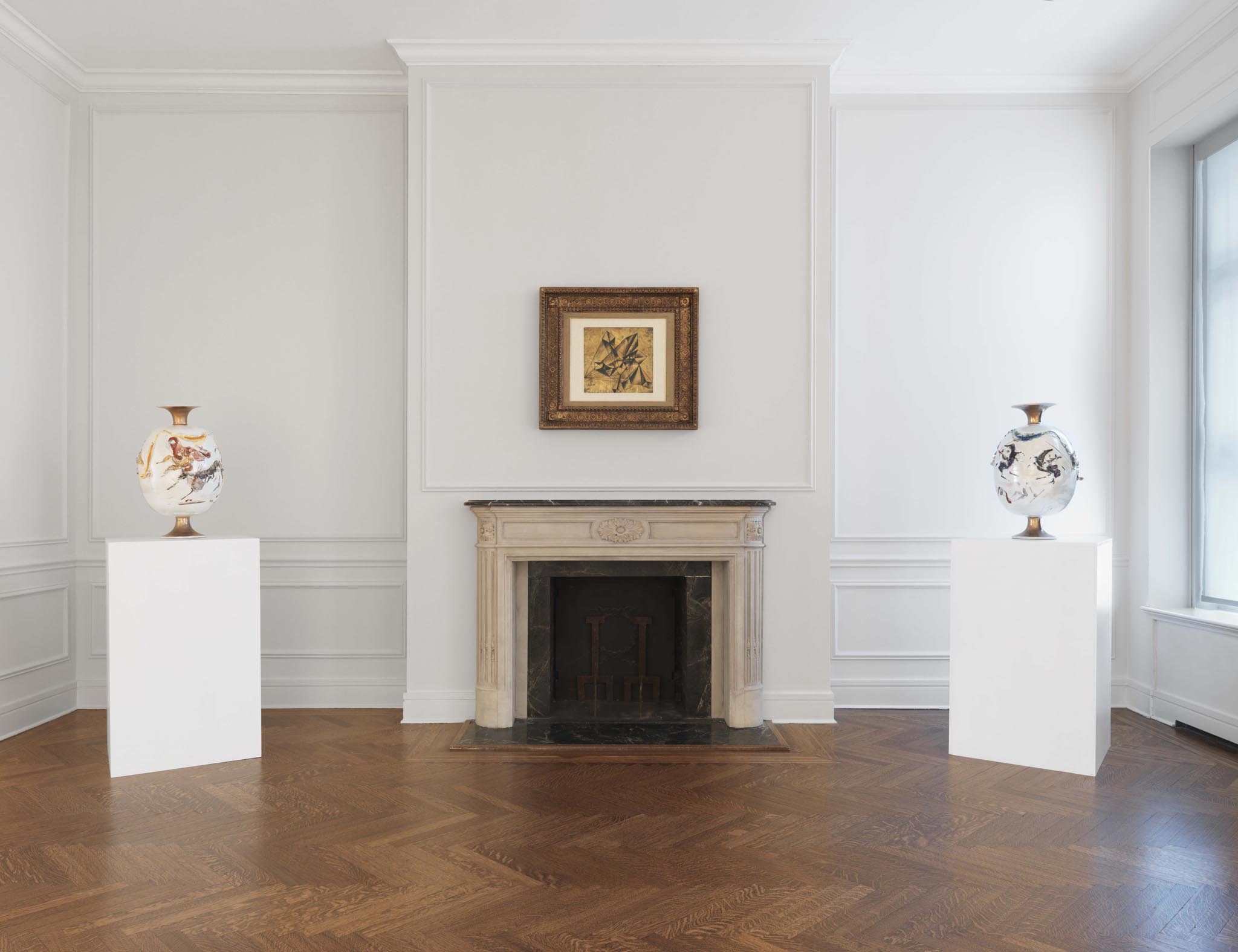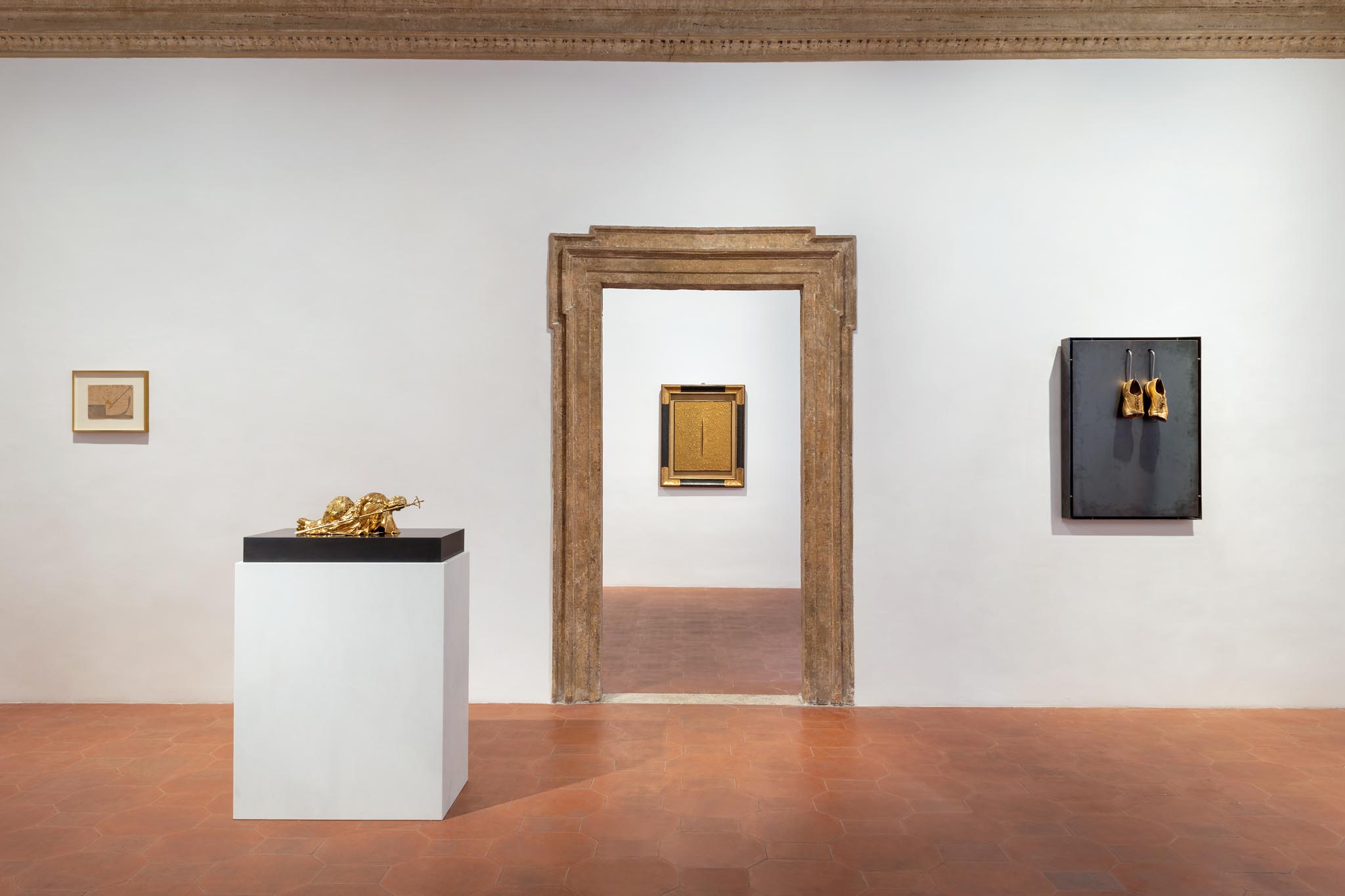Piero Manzoni was born in Soncino, Cremona, on July 13, 1933. From 1950 onwards, he received private painting lessons, gaining initial technical knowledge in the field. Concurrently, he briefly attended the free school of nude studies at the Brera Academy. In 1953, he committed more permanently to painting, particularly influenced by the Ligurian environment, characterized by ceramic kilns that attracted numerous artists, including Lucio Fontana. Shortly after, he started frequenting the studios of Roberto Crippa and Gianni Dova, establishing friendships with young artists such as Ettore Sordini and Angelo Verga. Together with Sordini and Verga, he debuted on August 11, 1956, at the 4th Soncino Fair held at the town’s Castello Sforzesco, as part of the 4th Market Fair. He showcased two works, Papillon fox and Domani chi sa. Shortly thereafter, he participated in the Premio di pittura San Fedele 1956 at the San Fedele Gallery in Milan. On December 9 of the same year, he published Per la scoperta di una zona di immagini co-signed with Sordini, Camillo Corvi-Mora, and Giuseppe Zecca, marking the beginning of a prolific series of posters from his early career.
In 1957, Manzoni participated in a group exhibition alongside Fontana, Enrico Baj, Sergio Dangelo, Bruno Munari, Arnaldo Pomodoro, and others. The exhibition was organized by Luca Scacchi Gracco at Galerie 17 in Munich. Towards the end of May, the Pater Gallery in Milan hosted an exhibition titled Manzoni, Sordini, Verga, featuring a concise yet authoritative introduction by Fontana. Simultaneously, Manzoni, Sordini, and Verga published the manifesto L’arte non è vera creazione…, At the San Fedele Gallery in Milan, Manzoni exhibited in Arte Nucleare 1957 marking the first occasion where he endorsed a manifesto not authored by himself: Contro lo stile. A few months later, he curated the Exhibition of Young Painters at the Jamaica Bar, a polemical gesture against the San Fedele Prize.
Manzoni’s initial steps in defining his artistic journey include two solo exhibitions. The first small one, on October 23, took place in the foyer of Teatro alle Maschere, followed by another on December 3 at the Corriere della Provincia Gallery in Como. It is during this time of artistic activism that he published a noteworthy piece titled Prolegomeni a un’attività artistica. And it coincides with his first experiments with acromes, initiated in the preceding months. In early 1958, the exhibition Fontana Baj Manzoni debuted at the Bergamo Gallery in Bergamo before later moving to the Circolo di Cultura Gallery in Bologna. Additionally, the same year he held a solo exhibition at the Pater Gallery featuring acrome works in plaster.
Meanwhile, the artist introduced a chalky substance called “kaolin” into his painting process, drawn from his experiences in Albisola. Kaolin, a white, crumbly clay widely used in ceramics and porcelain production, lends a white, opaque texture to the surface. In 1958, the Piero Manzoni Schilderijen exhibition took place at the Rotterdamsche Kunstkring, showcasing seventeen acrome works. Other exhibitions followed, including a group show at Pater with artists such as Biasi, Agostino Bonalumi, Enrico Castellani, Ralph Rumney, and Douglas Swan, as well as another at Prism Gallery in Milan featuring Biasi, Bonalumi, Castellani, Dangelo, Edoardo Fraquelli, Scacchi Gracco, Recalcati, and Sordini. During this period, Manzoni also participated in the Zero exhibition by the Dutch group at the Rotterdamche Kunstkring, later displayed at the G-58 Hessenhuis in Antwerp and the Galleria Appia Antica in Rome. Additionally, the gallery presented Bonalumi Castellani Manzoni at a later date, previously exhibited at Prisma in Milan, highlighting Manzoni’s new artistic affiliations.
In 1959, the official announcement heralded the birth of the magazine Azimuth in Milan, co-edited by Manzoni and Castellani. The inaugural issue’s tone aligns with the avant-garde journals prevalent at the time, yet it’s evident that Manzoni had a broader avant-garde group project in mind. He also contributed situational articles to the Roman magazine Il Pensiero Nazionale working on new texts, and, most significantly, co-founded the Azimut Gallery with Castellani. Situated in a basement at 12 Via Clerici, the gallery opened on December 4 with Manzoni’s solo exhibition Le Linee, inaugurated by Vincenzo Agnetti. In 1960, the group exhibition La nuova concezione artistica commenced at the Azimut Gallery. Alongside Castellani and Manzoni, artists such as Klein, Mack, Kilian Breier, Oskar Holweck, and Almir Mavignier exhibited their works. Shortly after, the exhibition was accompanied by the second and final issue of Azimuth, featuring texts by Castellani, Manzoni, Piene, and Udo Kultermann. Concurrently, Manzoni published a new theoretical text, titled Libera dimensione marking the genesis of the later stable terminology of Achrome.
The international impact of Libera dimensione was significant; it was translated into Japanese in July, appearing in issue 7 of The Geijutsu-Shincho, a magazine that had previously dedicated an article to Manzoni. The following year, after an exhibition with Bonalumi, Castellani, Peters, and others in Neue Malerei at the Galerie des Kleintheater in Bern, the London debut occurred on March 1 at the New Vision Centre, titled Castellani Manzoni. A New Artistic Conception.
Again, the impact of Manzoni’s work resonated strongly in northern Europe. A few months later, he held a solo exhibition titled Luftskulptur Billeder 9 Linierat Galerie Køpcke in Copenhagen. The exhibition featured six Achromes made of kaolin or machine-stitched materials, nine Linee, four Corpi d’aria, and notably, for the first time, a basket with eggs marked by his fingerprint. In the same year, 1960, Manzoni undertook a remarkable project at the print shop of the Herning Avis newspaper. He produced a continuous line stretching 7200 meters using a roll of printing paper (weighing 202 kg, as specified by the author), which was then sealed in a cylindrical zinc-lead container. According to his vision, this was the first of a series of Linee intended to be buried in major cities worldwide, with the collective length equating to the circumference of the Earth.
A few months later, Manzoni exhibited alongside Castellani, Fontana, and others in the entrance hall, curated by Ettore Sottsass Jr, at the 12th Milan Triennale. On July 30, he participated in a group show at the Circolo degli Artisti in Albisola with Castellani, Dada Maino, Pisani, and Santini. Then, on October 8, he showcased his work alongside Biasi, Bonalumi, Dada Maino, Massironi, and Santini in Riducibili at the Trastevere Gallery in Rome. November 11 saw him at the International Abstract Painting Exhibition at the Shen Sheng Pao Press Building in Taipei, alongside artists such as Castellani, Santini, Mack, Piene, Breier, Holweck, Mavignier, Uecker, and Tinguely.
In 1961, the exhibition Castellani & Manzoni took place at Plinio De Martiis’ La Tartaruga Gallery in Rome. Manzoni seized this opportunity to introduce his Living Sculptures and distribute his Authenticity Cards, two of which specifically related to the right shoes of Franco Angeli and Mario Schifano. In May, Manzoni created Merda d’Artista produced in ninety copies: sealed canning tins with a diameter of six centimeters, each bearing a printed label in Italian, English, French, and German, stating Artist’s Shit. Net content 30 grams. Preserved in the natural state. Produced and canned in May 1961, with a price set at thirty grams of gold. The work was unveiled to the public after being showcased in key exhibitions such as the Zero Edition Exposition Demonstration at Galerie Schmela in Düsseldorf, Internationale Malerei 1960-61 at the Deutsch-Ordens-Schloss, and Nove Tendencije at the Galerija Suvremene Umjetnosti in Zagreb. The first exhibition of Merda d’Artista occurred during the group exhibition In villeggiatura da Pescetto in Albisola, followed by a solo show in Milan in September at Luca Scacchi Gracco’s gallery, and another in October at Køpcke in Copenhagen.
From Copenhagen, Manzoni journeyed to Herning, where he created the renowned Socle du Monde, a metal base with the title of the work reversed, upon which the entire globe is positioned, designated as a work of art. Additionally, he experimented with Achromes using artificial fiber and crafted a spherical sculpture adorned with white rabbit fur, as well as a parallelepiped made of straw and kaolin resting on burnt wood bases. During this period, Manzoni continued to exhibit in various group shows, including those at the Städtisches Museum in Trier, Prisma, Galerie Dato in Frankfurt, and Galerie A in Arnhem.
In 1962, Manzoni played a prominent role in the groundbreaking Nul exhibition, curated by Willem Sandberg and organized by Henk Peeters at the Stedelijk Museum in Amsterdam. He exhibited several Achromes, including two made of synthetic fiber and one incorporating absorbent cotton balls, as well as samples of Merda d’Artista and likely the 1140-meter long line. Additionally, he created two works specifically for the occasion: a large panel adorned with tufts of synthetic fiber and a lengthy line crafted on continuous printing paper provided by the local newspaper Het Vrije Volk.
In 1963, Manzoni participated in the Mostra monocroma exhibition at Il Fiore Gallery in Florence. Shortly before his sudden passing due to a heart attack, he held a new solo exhibition at Galerie Smith in Brussels. This exhibition featured for the first time his Achromes with sandwiches applied to the support.

